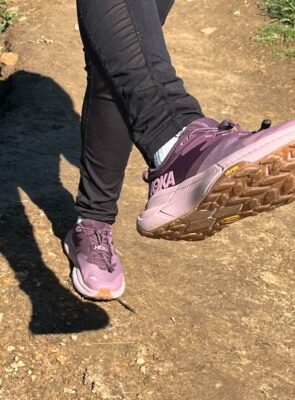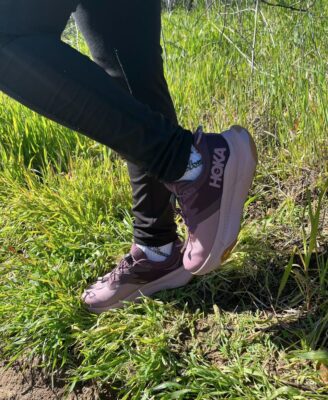No matter which way you slice it, Hoka has been up to a lot recently. It just surpassed $1 billion in sales, an impressive feat for any brand. In February, Hoka also released the Clifton 9 ($145), the newest installment in the beloved Clifton series, and, coincidentally, my new favorite running shoe. But the brand isn’t just updating its heavy hitters—it’s also releasing brand-new models, too, like the Hoka Transport ($140), which hit shelves earlier this year.
According to Hoka, the Transport was “conceived at the intersection of style and performance.” True to the brand, it has a thicker mid- and outsole that make for excellent balance and energy return, only it’s designed to accommodate commuters and city folks like myself. Notable upgrades include a toggle that make it easy to slip on and off instead of laces and a neutral footbed for natural stability on all sorts of surfaces. There’s also a slew of sustainable upgrades, too, including a sugarcane-infused midsole and Vibram Ecostep outsole that’s made with recycled materials, natural pigments, and less oil.
To see just how versatile the Transport is, I put a pair to the test on walks, runs, hikes, weightlifting sessions, and even during my nannying duties. (If they can keep up with me chasing kids around, they’re bound to be good, right?) Turns out, it’s the all-around lifestyle shoe I didn’t know I needed. Find my full review, below.
First impressions of the Hoka Transport
The first thing I noticed were the laces, which, as mentioned above, had been replaced with a stretchy cord and toggle. I also noticed that the soles were a lot less chunky than what Hoka’s known for, and that the grip on the outsole was similar to a trail shoe or hiking boot.
Dana Canuso, DPM, a podiatrist, surgeon, and founder of Dr. Canuso Skincare for Feet, explains these changes are deliberate. “The Transport is more like an everyday lifestyle shoe, it’s not really a sports shoe,” she says. Because of the cord laces and toggle, Dr. Canuso says, the Transport actually “fits your foot shape really easily, whether you’ve got a wider or thinner foot.” This means it’s especially great for issues like bunions or hammertoes, as it actually can accommodate them bit more compared to traditional laces.
As far as the mid- and outsole? They’re for better balance and stability. The original Hoka’s have a much more severe rocker footbed that’s particularly good for road and trail running—but not the Transport. “It’s a little bit more traditional in the sense that it’s not rocking you as much,” Dr. Canuso says. “This is a very neutral shoe, and some of the things that make it less ‘Hoka’ also make it better for someone who might have an orthotic.” In my non-expert opinion, the less-bulky sole also makes the shoes more stylish.
My new favorite mode of (Transport)ation
The very first time I wore my Hoka Transport sneakers was at an outdoor market, and then to work as a nanny. They garnered many compliments on both occasions. Once on, I was able to walk more than 20,000 steps in a day in total comfort—my feet didn’t hurt one bit. I was also able to chase after little kids for 10 hours with similar results, and welcomed their flexibility and midsole (which is made from 30 percent sugarcane and has a bit of bounce to it) while keeping up with the toddlers. Suffice to say, if I’m going to be on my feet all day, I’m doing it in the Transport.

They also make a stellar hiking companion. To test out their durability and ruggedness, I wore them on a steep and muddy hike and felt extremely secure the whole time thanks to the textured grip of the shoe. Going uphill was pretty easy thanks to the slight rocker bottom, and coming down, while scary, I only slipped a few times, never falling and able to catch my balance again.
The only place I didn’t love wearing them was in the gym. One morning, I corded these up (get it?) and went for a run on the treadmill. While I could comfortably run up to two miles in the Hoka Transport, I only did so a couple of times for this review’s sake. Simialrly, the Transport doesn’t shine on the weight-room floor—Dr. Canuso recommends even flatter shoes for those type of workouts. On both occasions, I didn’t love the experience, but if they’re the *only* option I had on a given day, I wouldn’t complain too much about it—I’ve exercised in worse.
Final thoughts
Let’s start with the good, of which there is a lot: The Transport is super comfortable to walk in and I felt like I could wear it all day. It’s also extremely stylish, which makes it the perfect lifestyle shoe. I can wear these pretty much anywhere I go and feel confident I’m rocking the game. And, if I’m ever in the mood to run and this is my only option, I know I can get at least a mile in.
There isn’t that much bad—I mean, this is Hoka we’re talking about. True, the Transport isn’t great for working out in, but that’s not really what they’re designed for, so I’ll give ’em a pass. If I had to nitpick, I’d say the toggle is a bit hard to figure out. I wouldn’t go as far as to say I wish it had laces, but I do want to say: Don’t overcomplicate the cord. To tighten it, pull it toward the shoe. To loosen it, pull it away from the shoe. Simple as that.

Can confirm: The Hoka Transport is the everyday-lifestyle shoe you’ll want to wear, well, everyday. Dr. Canuso says that even if you want to sneak in a quick jog in or workout when you have to be on your feet the rest of the day, it’s a great option in a pinch. “This might be a good introduction to Hoka if you want to start using rocker-bottom running shoes but don’t want to go full-fledged into it,” she says.
Currently, the Hoka Transport is available in three styles, all of which feature slightly different specs: The Women’s Transport ($140), Men’s Transport ($140) and the All-Gender Transport ($140). Happy strolling!
Our editors independently select these products. Making a purchase through our links may earn Well+Good a commission.
